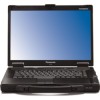Panasonic Toughbook 52 Mapping Technical and Operational Challenges of Mobile - Page 2
I. Improving Mobile Investment Decisions, Through Tco Analysis - drivers
 |
View all Panasonic Toughbook 52 manuals
Add to My Manuals
Save this manual to your list of manuals |
Page 2 highlights
A critical aspect of any successful TCO analysis needs to include the business elements of TCO. Today's enterprises are continuing their transformation to highly fluid and distributed organizations where key decisions are being made at the point of interaction. Ultimately, the ability to improve employee decision-making speed and scalability at the edge of an organization is what is setting apart best-in-class operations. As a result, organizations are looking to mobile computing and wireless communications solutions to enable these real time remote transactions. However, organizations are also frequently making these investment decisions with incomplete information or a general misunderstanding of the environments within which mobile technologies are being used. Coupled with the impact of today's tough economic climate and pressure to cut costs, this frequently translates into mobile workers being equipped with devices that do not map to their real-world requirements. The consequences can be severe, including higher ownership costs and, potentially, customer service lapses and even lost revenue. To avoid these missteps, VDC Research is proposing a fresh approach to how organizations evaluate mobile computing solutions for their mobile workers. VDC Research believes that a model that focuses on the most powerful technical and operational cost drivers will provide customers with an accurate baseline from which they can make mobile and wireless investment decisions. A critical aspect of any successful TCO analysis needs to include the business elements of TCO. These include anticipated length of deployment and planned replacement cycles, failure rates and causes of failure, the opportunity cost of lost productivity-to name a few. Of equal importance to TCO is an analysis of the end user's needs based on their work flow and work environment. This will impact decisions on the appropriateness of a mobile platform in terms of form factor, functionality, connectivity and durability. Only through this kind of analysis can organizations determine which solutions will best serve the company. I. IMPROVING MOBILE INVESTMENT DECISIONS THROUGH TCO ANALYSIS For nearly a decade, suppliers and users of both rugged and commercial grade mobile computing solutions have been debating the merits and limitations of both classes of solutions. TCO has often been upheld as the definitive metric by which the cost-effectiveness of any mobile computing solution can be measured. During that decade, however, definitions of every single dimension of the mobile computing market have changed. So, too, have the definitions of TCO. With all these moving parts, it is nearly impossible for users to be confident in the accuracy of their TCO modeling during their evaluation or deployment. In this challenging business climate, now is no time to make the wrong investment decision based on flawed TCO modeling. It is critical that users find and use a simple, reliable TCO model. © 2009 VDC Research Group, Inc. 1











